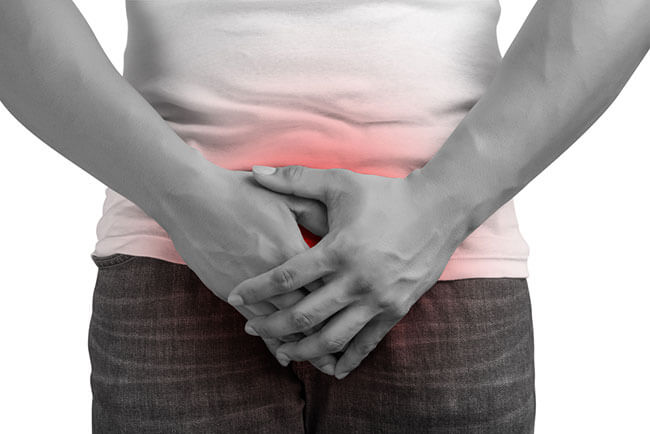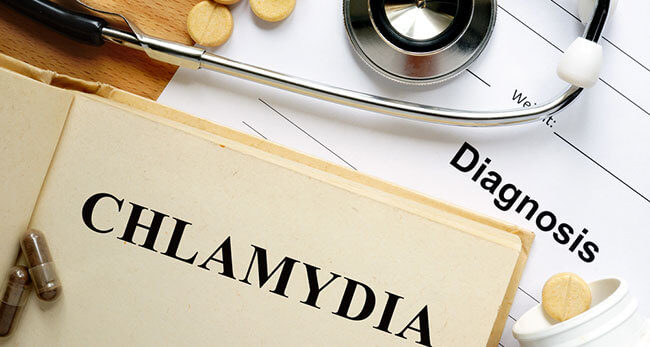Chlamydia is one of the most common sexually transmitted diseases in the US. Caused by the bacterium Chlamydia trachomatis, the STD usually presents no symptoms in infected individuals. If the symptoms do occur, however, it usually takes them a few weeks to develop (between 1 and 3).
It is very important to get tested for chlamydia and other STDs if you have reasons to suspect recent exposure. Getting tested is the only way to detect the infection since its symptoms (in the rare cases when they do occur) can be mistaken with many other health issues.
This comprehensive guide to the symptoms of chlamydia in men will cover not just the signs of the STD but also diagnosis, what to expect from the test, potential treatment options, some common chlamydia myths, and prevention measures you can take to avoid getting infected in the first place.

Typical Chlamydia Symptoms In Men
As we already mentioned, chlamydia falls under the category of “silent” STDs. In other words, infected men (and women) can carry this infection for prolonged periods of time without exhibiting any symptoms. When the symptoms do present themselves, we differentiate between:
- Least common – This group of symptoms includes a sore throat (throat infection), testicular pain and swelling, and burning/itching around the opening of the penis.
- Less common – This group includes conjunctivitis, rectal discharge/pain/bleeding, pain during urination, and abnormal penile discharge (yellow-white, thick, milky or watery).
- Most common – Most individuals infected with chlamydia exhibit no symptoms whatsoever (men: around 50%; women: around 70%).
As you can see, chlamydia symptoms in men are not limited to the genitals. Depending on how the infection is transmitted, they can also occur in your eyes, throat, and rectum.
What Happens If Chlamydia Goes Untreated?
One of the most serious (and often neglected) consequences of an undetected and untreated chlamydia infection is male infertility. Namely, chlamydia in men can scar the reproductive tract and damage the sperm. Men with a chlamydia infection exhibit three times the regular level of DNA fragmentation in their sperm. This simply means that longer DNA strands become more susceptible to breakage since the genetic material is not packed as tightly anymore. Men with chlamydia produce sperm with 10% less mobility and 80% more physical abnormalities compared to their infection-free peers.
Additionally, chlamydia in men can also cause urethritis, reactive arthritis, conjunctivitis, and numerous rheumatological conditions.
How Is Chlamydia Diagnosed?
Chlamydia symptoms in men are not enough for the doctor to recognize and diagnose the infection. The only way to be 100% sure of your status is to perform a dedicated chlamydia test or an STD panel. If you suspect a chlamydia infection, you should definitely test for other common STDs as well.
Chlamydia tests most commonly require a urine sample. In order to get accurate results, you should not pass urine for at least 2 hours before the test. If you are experiencing chlamydia symptoms after engaging in anal or oral sex, your physician should take a swab of your throat or rectum instead of your urine sample. Your sample will be shipped to the lab for analysis and you will have your results in just a few days. Keep in mind that some direct-to-customer STD testing companies even offer next-day results.
How Is Chlamydia Treated?
Chlamydia in men is very easy to treat. If you test positive for this infection, you will probably be prescribed a single dose of antibiotics (Azithromycin, for example). Modern services even allow you to order treatment online without any human contact whatsoever. It is also very important that you contact all your previous sexual partners and tell them they need to get tested for chlamydia as well.

How To Prevent Chlamydia?
If reducing the number of sexual partners is not an option, here are some measures you can take to lower the risk of contracting chlamydia or passing it on:
- Make sure you always use condoms regardless of the type of sexual intercourse (oral, vaginal or anal).
- Cover any sex toys you share with your partners with condoms.
- Check yourself and your sexual partners for STDs before practicing unprotected sex.
Chlamydia Myths
Here, we will address the 3 most common questions about chlamydia symptoms in men.
Can I diagnose a chlamydia infection by comparing my visible symptoms with online pictures?
NO! Comparing your visible symptoms to an image you found online is one of the worst things you can do trying to diagnose chlamydia. Some of these pictures are quite graphic as they are designed to deter individuals from engaging in unprotected sex. Additionally, chlamydia shares a lot of its symptoms with other STDs, so if you misdiagnose yourself and start self-medicating, you can do much more harm than good.
Can a doctor diagnose chlamydia by looking at my visible symptoms?
NO! As we already repeated a couple of times, the only way to make sure of your chlamydia status is to get tested. If you visit a doctor for a physical examination, they may suspect a chlamydia infection, but they will have to perform a proper test in order to confirm the diagnosis.
No penile discharge means no chlamydia, right?
WRONG! By now, you know that chlamydia is symptom-free in most cases. On the other hand, penile discharge doesn’t automatically spell chlamydia. Apart from this STD, penile discharge can also be a sign of genital herpes, urinary tract infection (UTI), gonorrhea, ureaplasma, mycoplasma genitalium, and other conditions.
